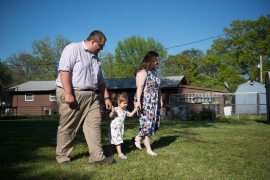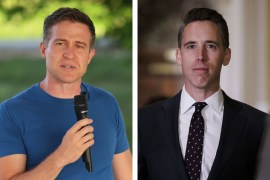When Donna Helen Crisp, a 59-year-old nursing professor, entered a North Carolina teaching hospital for a routine hysterectomy in 2007, she expected to come home the next day.
Instead, Crisp spent weeks in a coma and underwent five surgeries to correct a near-fatal cascade of medical errors that left her with permanent injuries. Desperate for an explanation, Crisp, who is also a lawyer, said she repeatedly encountered a white wall of silence: The hospital and her surgeon refused to say little more than “things didn’t go well.” Crisp spent years piecing together what happened. “I decided I was going to find out even if it takes the rest of my life,” she said.
Jack Gentry said he “went into the hospital a patient and came out a victim.” In 2013, the retired Baltimore police officer suffered a catastrophic spinal cord injury during disk replacement surgery at MedStar Union Memorial Hospital that left him a quadriplegic.
But unlike Crisp, Gentry and his wife, a nurse, were immediately told what had gone wrong by his surgeon, who apologized for the error. The hospital covered Gentry’s rehabilitation and other major expenses and paid an undisclosed amount in compensation, all without litigation.
“When hospitals mess up, they need to do the right thing,” Gentry said. “MedStar did.”
For patients and their families killed or maimed by medical errors, Crisp’s experience — in which doctors clam up and hospitals deny wrongdoing and aggressively defend their care — remains standard operating procedure in most institutions.
But spurred by concerns about the “deny and defend” model — including its cost, lack of transparency and the perpetuation of errors — programs to circumvent litigation by offering prompt disclosure, apology and compensation for mistakes as an alternative to malpractice suits are becoming more popular. Researchers at Johns Hopkins University in Baltimore recently estimated that medical mistakes kill 251,000 Americans annually, which would make them the third-leading cause of death. Traditionally, the only way for patients to find out what went wrong has been to sue.
A blueprint for the approach used in Gentry’s case is being promoted by the federal Agency for Healthcare Research and Quality. Called CANDOR, an acronym for Communication and Optimal Resolution, the approach is modeled on a long-standing program pioneered at the University of Michigan. It was tested in 14 hospitals around the country, including MedStar’s Washington Hospital Center and Georgetown University Hospital.
Although they differ, these programs — which typically feature prompt investigation of errors whose findings are shared with the victims, as well as an apology and compensation for injuries — are operating at the University of Illinois at Chicago, Stanford and eight hospitals and outpatient groups in Massachusetts. Despite fears that the new approach would encourage lawsuits, the opposite has proved true. In Michigan, the number of lawsuits was cut nearly in half, and the hospital system saved about $2 million in litigation costs in the first year after the new model was adopted in 2001.
“The whole point of this isn’t to drop malpractice costs, it’s to drive patient safety,” said Richard Boothman, the University of Michigan Health System’s executive director of clinical safety and chief risk officer, who launched the program after a career defending doctors and hospitals. “We need to hard-wire as quickly as possible the lessons of these cases.”
In most hospitals, Boothman said, patient safety experts do not routinely talk to risk managers who handle malpractice claims. As a result, valuable information about preventing errors is lost.

Donna Helen Crisp spent weeks in a coma and underwent five surgeries after a near-fatal cascade of medical errors. (Courtesy of Rebekah Lee Crisp)
In The Dark
Most patients never learn they are victims of a medical error. A landmark 1991 Harvard study found that only 2 percent of people harmed by errors file a lawsuit. Those who do face daunting odds: Patients lose 80 percent of malpractice cases. Huge litigation costs, combined with laws that have reduced damage awards in many states, have left many unable to find an attorney because plaintiffs’ lawyers are paid on contingency. Malpractice cases typically take three or more years to resolve. In the interim, many injured people struggle to pay for care.
Litigation “is a tortuous process for patients and health care workers,” said Beth Daley Ullem, who spent five years seeking answers about the 2003 death of her newborn son from a Chicago hospital that denied any wrongdoing.
“We later learned that this had happened to a family before us and another seven months after,” said Daley Ullem, a former McKinsey & Co. consultant whose ruptured uterus went untreated for an hour. She said she received a $4 million settlement before trial, which she offered to give back to the hospital to fund safety improvements. The hospital refused.
Disclosure efforts also face stiff resistance from doctors, insurers and lawyers, including defense attorneys for whom speedier resolution means fewer billable hours.
Despite laws in most states that prevent apologies from being used against doctors in lawsuits, many worry that it will make patients more likely to file suit, said Thomas Gallagher, a University of Washington professor of medicine who has written extensively about disclosure. A recent study found that 77 percent of 300 primary-care doctors would not fully disclose a delayed breast cancer diagnosis to a patient.
Doug Wojcieszak — who founded an Illinois-based disclosure advocacy group called “Sorry Works!” — said one Iowa doctor told him that if he started apologizing when things went wrong, “he’d be doing nothing else all day long.”
Insurers are also leery, said Brian Atchinson, president of Physician Insurers Association of America, the trade association for liability insurers, which was involved in the development of CANDOR. “Some states are more conducive to this than others,” he said. “But there are those who don’t believe the benefits outweigh the risks.”
Lawyer Joanne Doroshow, director of the Center for Justice & Democracy at New York Law School, expressed worry that disclosure programs may take advantage of vulnerable patients who are not represented by a lawyer. “The hospitals are in control of it, and it’s still in their interest to try and limit compensation to patients,” she said.
Jeffrey Catalano, a Massachusetts plaintiffs’ lawyer who is president of the state bar and a participant in that state’s disclosure program, says that patients should be represented early in the process. “I think if there’s a good attorney present, there’s no way a client is going to be shortchanged,” he said. “Good attorneys know this: Medical malpractice cases are hard to take to trial. If a client can get $1 now rather than risking getting nothing [at trial] for the prospect of $1.50 later, it may be better to take the $1 now.”
Doing The Right Thing
The country’s first disclosure program began 30 years ago with a doctor’s desire to do the right thing.
Pulmonologist Steve Kraman, newly named as chief of staff for what is now the Lexington Veterans Affairs Medical Center in Kentucky, said he faced a problem in 1987: how to handle the death of a middle-aged woman caused by an “undeniable error,” a massive overdose of potassium.
“If we had said nothing, [the family] never would have known a thing,” said Kraman, who was also the hospital’s risk manager. “We never would have gotten sued. But I just didn’t feel that was right.” So he suggested to the hospital’s lawyer that they come clean to the patient’s two adult daughters, from whom she was estranged.
“I sat down and told them exactly what happened, that we were responsible for it, that they should hire a lawyer and we were going to negotiate a payment,” he recalled. Two months later, the family was paid $250,000.
From then on, Kraman said, all cases involving errors were handled similarly. “We paid out for things that nobody could have sued for in their wildest dreams,” said Kraman, who is now a professor at the University of Kentucky. Some patients declined the cash, he said, because they feared it would “ruin their relationship with the doctor.” Kraman said he refused to pay a dime in cases where no injury could be proved. “That just alienates doctors and nurses who feel like you’re throwing them under the bus.”
Kraman said he had several advantages: Doctors were employed and insured by the VA system. Payments, which averaged $16,000, were made from the U.S. Treasury, not the hospital coffers. And the program had the support of the hospital’s director and lawyer as well as the U.S. attorney for Kentucky.
“This has to be done from the top down” or it won’t work, Kraman said. “The message has to be ‘This is how we do business.'”
When Boothman arrived at the University of Michigan in 2001 — after two decades defending doctors, including an orthopedic surgeon who had been sued 21 times — he decided to try a similar approach. That included encouraging staff to report errors and bad outcomes; reports jumped from 2,400 a year to more than 34,000.
“You have to normalize honesty,” Boothman said, “to create a culture of continuous improvement.” Applying the lessons gleaned from those errors, he said, has helped make care safer.
“Litigating a case for three years and telling everybody, ‘Don’t talk about it and don’t change anything,’ is immoral and counterproductive,” he added. “I don’t serve my organization well by defending care we shouldn’t be defending.”
“Today we’re often at the bedside as soon as things happen,” he said. Patients and their families are interviewed as part of the hospital’s investigation of the facts, something that does not happen in traditional litigation.
Like Kraman, Boothman said he worries that some hospitals are using disclosure to cherry-pick small or unwinnable cases, not as a standard approach.
A Test Case
Orthopedic surgeon P. Justin Tortolani remembers with sickening clarity the moment he realized that a device he was installing had gone too far, penetrating Jack Gentry’s spine. The 60-year-old retired police officer, who once had hiked the entire Appalachian Trail, was instantly paralyzed from the neck down.
“You can’t really believe it’s happening,” said Tortolani, Union Memorial’s director of spine surgery. Summoning his years of training, the surgeon formulated a plan and steeled himself to tell Teresa Gentry what had happened. It was the first of many conversations about the accident that he would have with the family.
“We didn’t want to go through litigation, we didn’t need to go through litigation,” said Larry Smith, MedStar’s vice president for risk management. MedStar uses CANDOR in about a dozen cases with substantial damages annually.
MedStar executives “told me what had happened, why it happened, that it was directly or indirectly their fault and that whatever I needed I should ask for,” Gentry recalled. MedStar paid for five months of inpatient rehab — Gentry’s insurance would have covered only two weeks — modifications to the couple’s home, a $45,000 wheelchair and a new wheelchair-accessible van. It provided a case manager, a home-care nurse and $15,000 for incidental medical expenses.
“Because of the nature of Jack’s injury, we would have had to mortgage everything to pay for his care” otherwise, Teresa Gentry said.
Early on, Gentry said, his older brother, a Baltimore malpractice lawyer, expressed bafflement at MedStar’s approach. “He said as long as we were getting what we needed, to just go with it,” Gentry recalled.
At the end of two years, the case was settled with a confidential payment negotiated by lawyers for the couple, MedStar and the device manufacturer.
“I felt like it would take care of Jack for the rest of his life,” said Teresa Gentry, adding that the couple had been prepared to file a lawsuit if an agreement could not be reached. “Did I get enough to pay for everybody’s pain and suffering and trauma? No.”
“I was very skeptical in the beginning of this whole process,” she recalled, but she said she believes it has worked well, as does her husband.
Tortolani said he feels “remorse, guilt and sorrow for Jack and his family. This shakes you to your core,” he said. MedStar officials have been “unbelievably supportive,” Tortolani said, and he remains deeply grateful to the Gentrys. “My relationship with Jack has never been stronger.”
Donna Helen Crisp says she thinks she would have been less traumatized had the North Carolina hospital and her surgeon not stonewalled her. “I would have been deeply depressed that I had such a bad experience, but I could have moved on with my life,” said Crisp, who has written a book about her experience entitled “Anatomy of Medical Errors: the Patient in Room 2.” Being denied the truth left her with “no way to put it into perspective.”








